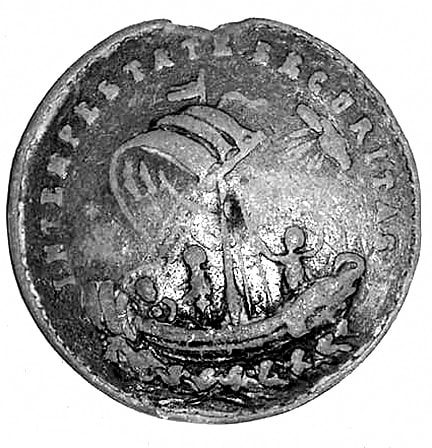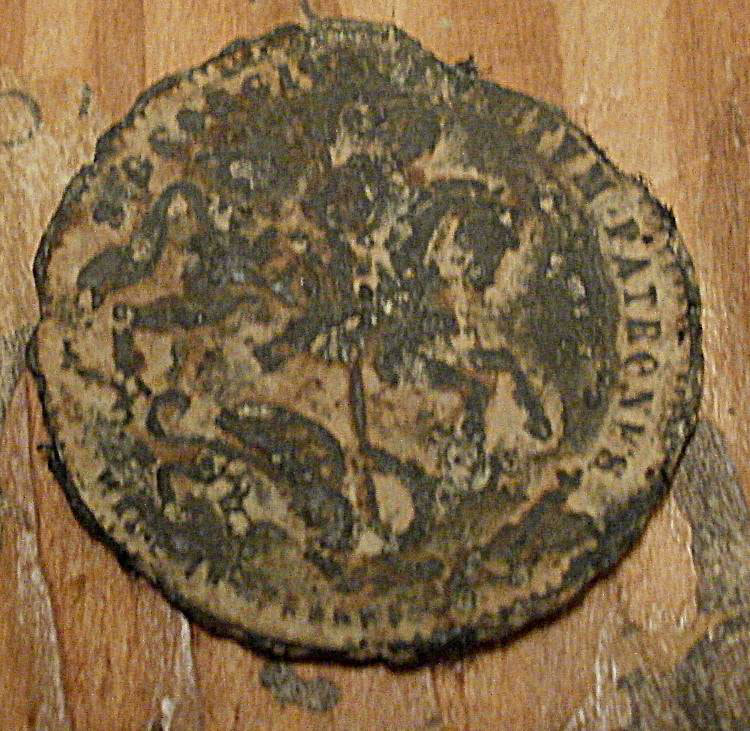Tale of Two Medallions
|
Since New Ross, Nova Scotia is located less than 20 miles from Oak Island, it not only shares in a similar history, but also shares in similar types of finds being made there. At the very least, this proves that some kind of civilization or community existed at both place long before the Money Pit discovery of 1795.
Two of these discoveries made at New Ross involve medallions that were found in the area. Both of these medallions are extremely rare, with only a few other examples in existence. One is purported to be a knighthood medallion for the Order of the Garter, the top knighthood in Great Britain. It is said to be in the possession of an elderly man who has shown it to various treasure hunting groups through the years. How this valuable and specific medallion would ever end up at New Ross is a major mystery to be solved. I hope to add some insight about it with this article. Below is a photo of a similar medallion held by the British Museum. As with the New Ross medallion, this is dated 1671. There are only three men this could have originally belonged to, which I will explain soon. This is the front of the 1671 medallion and the inscription reads (in French):
EN HONNEUR DU SOUVERAIN DU TRES NOBLE ORDRE DE LA IARTIERE. This translates as: "In honour of the Sovereign of the most noble Order of the Garter." This is the backside of the same medallion. The inscription on the reverse side reads (in French):
Du TRÉ HAUT TRÉ PUISSANT ET TRES EXCELLENT PRINCE CHARLES . II . PAR LA GRACE DE DIEU ROY DE LA GRANDE BRETAG : FRAN : ET IRLANDE DEFENSEUR DE LA FOY . M . D . C . LXXI. Translated into English, this reads: "Of the most high, the most puissant, and most excellent Prince, Charles II, by the grace of God, King of Great Britain, France, and Ireland, Defender of the Faith. 1671." Above is the only photo I have of the actual New Ross 1671 medallion, although I have been promised a better one. If it arrives, I will replace this image.
Here is a similar medallion struck in 1678, and found in a coin and medallion collectors catalog. This 1678 medal almost certainly belonged to Sir Thomas Osborne. On June 19, 1673, Thomas Osborne became lord high treasurer of England and chief minister of Charles II. For the five years from 1673 to the end of 1678, the government of the country lay in his hands.
While the 1678 medallion does not have anything to do with Nova Scotia, it does help show what the medallion looked like when compared with the photo of the medallion from New Ross. So who could have been the owner of the original New Ross 1671 medallion? The answer may surprise you. There are only three choices as shown in this list taken from the official Order of the Garter list of recipients: No. 469 Charles XI, King of Sweden. No. 470 John George II, Duke of Saxony. No. 471 Christopher (Monck) 2nd Duke of Albemarle. The photos shown here of the 1671 medallion, front and back, are of the medallion given to John, Duke of Saxony. According to the British Museum – "to commemorate the installation, at Windsor, 29 May, 1671, of John George II, Elector of Saxony, as a Knight of the Garter. The medal is thin, in low relief, and of rude execution; the letters of rude and ancient form. All this designedly to give an air of antiquity." That leaves only the King of Sweden and Christopher Monck. I am trying to find information on whether the King of Sweden medallion still exists in Sweden or elsewhere, but there is no logical reason his medal would have ended up in New Ross, Nova Scotia. |
The same cannot be said for Christopher Monck!
If you think you've heard that name before, you just might have. In 1686, Monck was a major investor in a treasure-seeking expedition headed by William Phips, who had located the wreck of the Spanish treasure ship Nuestra Señora de la Concepción in February 1687. Phips returned to London with more than £200,000 worth of treasure, of which Monck received a 25 percent share. After serving in a few more minor positions, in 1687, Monck was appointed Lieutenant Governor of Jamaica, and left England for the New World. Why this is of interest, and some of you probably already have guessed, is that one of the main theories about what is buried on Oak Island is treasure from the Nuestra Señora de la Concepción! The theory says that Phips, wanting to save more of the treasure for himself, buried part of it in Nova Scotia, perhaps on Oak Island or New Ross. He began his recovery operation in 1687. Through March and April the divers and ships' crews worked to recover all manner of treasure: silver coins, silver bullion, doubloons, jewelry, a small amount of gold, and other artifacts. Concerned about the possibility of mutiny, Phips guaranteed the crew, who had been hired for seaman's wages, that they would receive shares in the find, even if he had to pay them from his own percentage. As he arrived in England, the treasure weighed in at over 34 tons, or £205,536. Almost a quarter went to Albemarle. Phips, after paying out £8,000 in crew shares, received only £11,000. Obviously, £11,000 was a paltry sum to be paid for pulling up a treasure worth £205,536. One theory says that some of the treasure from the Nuestra Señora de la Concepción was hidden by Sir William Phips in order to support a conspiracy to replace the King of England. So this does connect a holder of a 1671 Order of the Garter medallion with the area surrounding Oak Island (including New Ross, where the medallion was found). However, how Phips would have gotten ahold of Monck’s medallion, and why he would leave it at New Ross, is the big question. In late April, 1690, leading a fleet of seven ships and over 700 men, Phips sailed from Boston to the Acadian capital of Port Royal. On May 9th he summoned governor Louis-Alexandre des Friches de Meneval to surrender. Meneval, in command of about 70 men and a fort in disrepair, promptly negotiated terms of capitulation. When Phips came ashore the next day, it was discovered that Acadians had been removing valuables, including some that were government property. Phips burnt the town and took prisoners back to Boston. In support of the story that he may have hidden some treasure to support the new King of England, the new monarch appointed Phips as the first royal governor, under a newly issued colonial charter for the Province of Massachusetts Bay. So Phips was actually governor of Nova Scotia from 1691 through 1695, when he got in trouble for what else? - withholding the governments share of customs money from the king, a deed very similar in nature to withholding some of the king's share of the treasure from the Nuestra Señora de la Concepción – showing that in fact, he was that type of person. Again, though this is a direct connection of a holder of a 1671 Order of the Garter medallion to an Oak Island or New Ross treasure theory, it still doesn’t explain how Phips would have gotten possession of Monck’s medallion to leave it behind at New Ross. However, I do have a theory for this, as well. I searched through all lists of British knighthoods and one name that decidedly does NOT appear on ANY list is that of William Phips, the man who recovered the Concepción salvage treasure. James II was king of Great Britain for a very short time, and was ousted by William and Mary. Phips was said to have returned from Great Britain after delivering the Concepción treasure, with a knighthood supposedly granted on June 28, 1687, by James II. James only invested seven men into knighthood in that year according to all comprehensive lists I could find. None were knighted on June 28th. Six were Knights of the Thistle of Scotland, who were not even recognized as having any real power as a knight, due to their Jacobite leanings. The seventh was a Knight of the Garter, but not William Phips. Even looking into the following year there is no William Phips listed. In fact there is no William Phips listed on any type of British knighthood list. What this leads me to believe is that Phips was hastily given an honorary knighthood and the Order of the Garter medallion of Christopher Monck for his service to James II and Monck, who ended up with the majority of the vast treasure. Monck was leaving soon for a post in Jamaica, where he died the following year. Phips had no royal title or British noble heritage, which was typically a prerequisite to becoming a knight. He was born a poor man in America. Certainly Monck, who was a made a millionaire in today's money a few times over by the Concepción treasure, would gladly give up a simple medallion in return. Even Cotton Mather, who wrote a book about Phip's life, states that the knighthood was given in this way: “Accordingly the King, in Consideration of the Service done by him, in bringing such a Treasure into the Nation, conferr'd upon him the Honour of Knighthood.” Another medal was struck which was given to all the ship's officers and promoters of the venture, but certainly this was not a knighthood medal given to that many men, with no record of it made on any knighthood list. It could be that the officers and promoters received a simple medal, and Phips received an honorary knighthood medallion. If this is the case, then the 1671 medallion found at New Ross could belong initially to Monck and could have late been given as an honorary knighthood token of great appreciation to Phips. |
Phips was known as the "New England Knight." He was also found to be a somewhat of a scoundrel in the Salem witch trials, in possibly keeping part of the Concepción treasure, and finally in being arrested for withholding tax or tariff money from the new King William.
Whether he buried any treasure in Nova Scotia or not, he was the governor for several years and it appears he laid the law down in many places across Nova Scotia, at least allowing for him to have been at New Ross. This would give hopefully a not too convenient explanation to how a medallion of a 1671 Order of the Garter knight would end up at New Ross. I can think of no other scenario that even comes close to fitting the facts, besides this one unless, perhaps, Monck traveled to New Ross himself in search of the treasure Phips was supposed to have hidden. However, this theory is weak only because Monck was already made incredibly wealthy by Phips venture to recover the Spanish treasure, so why traipse around the wilds of Nova Scotia, when he could just go to Jamaica and take life easy? Monck's share of the Concepción came to over two million dollars in today's money. Monck did come to America and eventually held a high office in Jamaica. What a lot of people don't realize is that there was steady traffic between Nova Scotia and Jamaica back then, both being British territories. Typically northern climate products were being shipped south and Jamaican rum was being shipped to Nova Scotia. It seems highly possible that Phips, after bringing such a great treasure to Monck and the king, was made an honorary knight, being given Monck's own medallion, which later ended up in New Ross. Now to the second medallion – Above is the front of a medallion recently discovered by the Finders Keepers group of treasure hunters. They provided me with the two images posted here. Below is the backside of the medallion.
This one is a sailor's good luck amulet. The front shows the same type of image of St. George slaying the dragon. This has long been known to represent chivalry. Even though the Order of the Garter was an English medallion, the words were in French, because that is where the idea for the St. George Order of the Garter knighthood took root. However, on the sailor's medallion, the words are in Latin.
The back of this sailor's medallion shows Jesus in a boat with two disciples, calming the seas, and this is why it is a good luck medallion or amulet for sailors. The fact that it was found at New Ross indicates a French sailor being there. This would not be out of the question as it appears the French knew about the "secret estate" of the Alexanders at New Ross, near where this medallion was found. While the lettering around the perimeter is written in Latin, the type under the dragon may read "Made In France," but may also be Latin for "Mari In Franc," which can be translated as "France At Sea," making complete sense for a French mariner to have. One way or another, it seems to have come from a French sailor, and since the chain hole at the top is broken off, it may have been torn off in battle, which would also make sense. Mari means "sea," in Latin. In means "in, on, upon, at," and Franc means "France." The other choice is that it says "Made in France," but it would seem very odd that this line would be written in English and the rest of it in Latin, when it is a French medallion. So I highly doubt the "made in France" interpretation. It is said to be dated to the early 1630s, though I haven't yet seen the actual documentation on that. But if this is true, this medallion fits in exactly with my story of the de la Tour and Alexander families in that area after 1632. Below is an additional similar sailor's medallion found over 25 years ago, although I do not know the owner or the location. And finally, there is a snippet possibly showing how the line in Latin translates as "France At Sea," or in Latin, "Mari In Franc." The bottom line is that with proactive teams like the Laginas and Company on Oak Island, and the Finders Keepers at New Ross, I suspect we are just getting started with the fantastic finds. While I need a short break from posting to take care of other things, stay tuned to this website for more Good Stuff!
|








